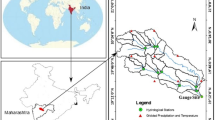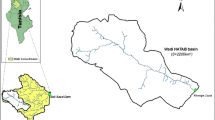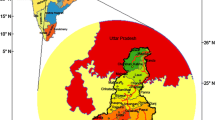Abstract
The management of surface water in basins has become of the utmost importance, especially given the expected changes in climate and land use. Therefore, the current work aimed to aid the management of the Khazir River basin by estimating sediment yield and surface runoff using the Soil and Water Assessment Tool (SWAT) at the hydrological response unit (HRU) spatial level. The SWAT model was used to simulate hydrological processes and sediment transport at different spatial and temporal scales in the basins. The study of sub-basins allowed more precise targeting of the best management practices through analysis and evaluation. The accuracy of, uncertainty in, and sensitivity of the parameters were evaluated by comparing observed and simulated daily data for average surface runoff and sediment yield. The semi-automated sequential uncertainty fitting (SUFI-2) algorithm within the SWAT CUP model was employed to calibrate the model parameters using the time series for the period 2003–2008, and its validity was verified for the period 2009–2012. The surface runoff performance was good during calibration (Nash–Sutcliffe efficiency (NSE) = 0.77) and very good during verification (NSE = 0.82), while it was good for sediment yield during the calibration and validation periods (NSE = 0.71 and NSE = 0.75, respectively). The parameters related to the characteristics of sediment yield and surface runoff showed high sensitivity during calibration and validation, as they are affected by the length and degree of slope, vegetation cover, and the resulting soil exposure to water erosion. The obtained results were compared with the results of previous scientific studies conducted for North African basins, and this comparison indicated the need for continuous study of the spatial and temporal changes in the natural characteristics of the basins. The results could help basin managers to determine baseline rates of hydrological processes in light of expected future shifts in hydrological systems as a result of climate and land-use changes.









Similar content being viewed by others
Availability of data and material
The data mentioned in the paper that support the findings of this study are available from the corresponding author upon request.
References
Abbaspour KC, Vejdani M, Haghighat S, Yang J (2007a) SWAT-CUP Calibration and uncertainty programs for SWAT. In: Oxley L, Kulasiri D (eds) MODSIM 2007 International Congress on Modelling and Simulation. Modelling and Simulation Society of Australia and New Zealand, Hamilton, pp 1596–1602
Abbaspour KC, Yang J, Maximov I, Siber R, Bogner K, Mieleitner J, Zobrist J, Srinivasan R (2007b) Modelling hydrology and water quality in the pre-alpine/alpine Thur watershed using SWAT. J Hydrol 333:413–430. https://doi.org/10.1016/j.jhydrol.2006.09.014
Abbaspour KC, Rouholahnejad E, Vaghefi S, Srinivasan R, Yang H, Kløve B (2015) A continental-scale hydrology and water quality model for Europe: calibration and uncertainty of a high-resolution largescale SWAT model. J Hydrol 524:733–752. https://doi.org/10.1016/j.jhydrol.2015.03.027
Akoko G, Le TH, Gomi T, Kato T (2021) A review of SWAT model application in Africa. Water J 13(1313):1–20. https://doi.org/10.3390/w13091313
Al-Hussein AAM (2022) Estimation the volume of water erosion for Jadida valley basin in Erbil, Northern Iraq. Iraqi Geol J 55(2F):99–113. https://doi.org/10.46717/igj.55.2F.6ms-2022-12-21
Al-Hussein AAM, Sulaiman MAM, Al-Taee NT (2022a) Morphometric characteristics of Al-Khoser river basin by using GIS/Mosul—Iraq. Kirkuk Univ J Sci Stud 17(3):7–16. https://doi.org/10.32894/KUJSS.2022.134877.1067
Al-Hussein AAM, Khan S, Ncibi K, Hamdi N, Hamed Y (2022b) Flood analysis using HEC-RAS and HEC-HMS: a case study of Khazir River (Middle East-Northern Iraq). Water 14(3779):1–19. https://doi.org/10.3390/w14223779
Al-Hussein AAM, Hamed Y, Bouri S, Hajji S, Aljuaid AM, Hachicha W (2023) The socio-economic effects of floods and ways to prevent them: a case study of the Khazir River Basin Northern Iraq. Water 15:4271. https://doi.org/10.3390/w15244271
Arnold JG, Srinivasan R, Muttaih RS, Williamns JR (1998) Large area hydrologic modelling assessment. Part I: Model development. J Am Water Resource Assoc 34:73–89. https://doi.org/10.1111/j.1752-1688.1998.tb05961.x
Arnold JG, Moriasi DN, Gassman PW, Abbaspour KC, White MJ, Srinivasan R, Santhi C, Harmel RD, van Griensven A, Van Liew MW, Kannan N, Jha MK (2012) SWAT: model use, calibration, and validation. Am Soc Agric Biol Eng 55:1491–1508. https://doi.org/10.13031/2013.42256
Berteni F, Dada A, Grossi G (2021) Application of the MUSLE model and potential effects of climate change in a small alpine catchment in Northern Italy. Water 13(2679):1–21. https://doi.org/10.3390/w13192679
Chiang L-C, Liao C-J, Lu C-M, Wang Y-C (2021) Applicability of modified SWAT model (SWAT‑Twn) on simulation of watershed sediment yields under different land use/cover scenarios in Taiwan. Environ Monitor Assess 193(520):1–23. https://doi.org/10.1007/s10661-021-09283-9
Erraioui L, Taia S, Taj-Eddine K, Chao J, El Mansouri B (2023) Hydrological modelling in the ouergha watershed by soil and water analysis tool. J Ecol Eng 24(4):343–356
Gassman PW, Reyes MR, Green CH, Arnold JG (2007) The soil and water assessment tool: historical development, applications, and future research directions. Am Soc Agric Biol Eng 50(4):1211–1250. https://doi.org/10.13031/2013.23637
Hallouz F, Meddi M, Mahé G, Alirahmani S, Keddar A (2017) Modeling of discharge and sediment transport through the SWAT model in the basin of Harraza (Northwest of Algeria). Water Sci 64:1–10. https://doi.org/10.1016/j.wsj.2017.12.004
Kateb Z, Bouchelkia H, Benmansour A, Belarbi F (2019) Hydrological modelling using the SWAT model based on two types of data from the watershed of Beni Haroun dam, Algeria. J Water Land Dev 43(X–XII):76–89. https://doi.org/10.2478/jwld-2019-0065
Keshtegar B, Piri J, Hussan WU, Ikram K, Yaseen M, Kisi O, Adnan RM, Adnan M, Waseem M (2023) Prediction of sediment yields using a data-driven radial M5 tree model. Water 15(1437):1–28. https://doi.org/10.3390/w15071437
Khanchoula K, Amamrab A, Saaidia B (2020) Assessment of sediment yield using SWAT model: case study of Kebir watershed, northeast of Algeria. Big Data Water Resour Eng (BDWRE) 1(2):36–42. https://doi.org/10.26480/bdwre.02.2020.36.42
Krysanova V, White M (2015) Advances in water resources assessment with SWAT—an overview. Hydrol Sci J 60(50):771–783. https://doi.org/10.1080/02626667.2015.1029482
Li-Chi C, Liao Ci-Jyun Lu, Chih-Mei W-C (2021) Applicability of modified SWAT model (SWAT-Twn) on simulation of watershed sediment yields under different land use/cover scenarios in Taiwan. Environ Monit Assess 193(520):1–23. https://doi.org/10.1007/s10661-021-09283-9
Liu Y, Jiang H (2019) Sediment yield modeling using SWAT model: case of Changjiang river basin. IOP Conf Ser Earth Environ Sci 234:1–10. https://doi.org/10.1088/1755-1315/234/1/012031
Lu M, Hou Q, Qin S, Zhou L, Hua D, Wang X, Cheng L (2023) A stacking ensemble model of various machine learning models for daily runoff forecasting. Water 15(1265):1–19. https://doi.org/10.3390/w15071265
Ma L, Ascough JCII, Ahuja LR, Shafer MJ, Hanson JD, Rojas KW (2000) Root zone water quality model sensitivity analysis using Monte Carlo simulation. Trans ASAE 43(4):883–895
Mapes KL, Pricope NG (2020) Evaluating SWAT model performance for runoff, percolation, and sediment loss estimation in low-gradient watersheds of the Atlantic coastal plain. Hydrology 7(21):1–22. https://doi.org/10.3390/hydrology7020021
Marahatta S, Devkota LP, Aryal D (2021) Application of SWAT in hydrological simulation of complex mountainous river basin (Part I: model development). Water J 13(1546):1–19. https://doi.org/10.3390/w13111546
Markhi A, Laftouhi N, Grusson Y, Soulaimani A (2019) Assessment of potential soil erosion and sediment yield in the semi-arid N′fs basin (High Atlas, Morocco) using the SWAT model. Acta Geophys 67:263–272. https://doi.org/10.1007/s11600-019-00251-z
Martínez-Salvador A, Millares A, Eekhout JP, Conesa-García C (2021) Assessment of streamflow from EURO-CORDEX regional climate simulations in semi-arid catchments using the SWAT model. Sustainability 13(7120):1–23. https://doi.org/10.3390/su13137120
Moriasi DN, Arnold JG, Van Liew MW, Bingner RL, Harmel RD, Veith TL (2007) Model evaluation guidelines for systematic quantification of accuracy in watershed simulations. Trans ASABE 2007 50:885–900. https://doi.org/10.13031/2013.23153
Mullan D, Matthews T, Vandaele K, Barr ID, Swindles GT, Meneely J, Boardman J, Murphy C (2019) Climate impacts on soil erosion and muddy flooding at 1.5 versus 2°C warming. Land Degrad Dev 30(1):94–108. https://doi.org/10.1002/ldr.3214
Nearinga MA, Jettenb V, Bafautc C, Cerdand O, Couturierd A, Hernandeza M, Le Bissonnaise Y, Nicholsa MH, Nunesf JP, Renschlerg CS, Souchèreh V, van Oosti K (2005) Modeling response of soil erosion and runof to changes in precipitation and cover. CATENA 61:131–154. https://doi.org/10.1061/40792(173)482
Neitsch SL, Arnold JG, Kiniry JR, Williams JR (2011) Soil and water assessment tool theoretical documentation, version 2009. USDA Agricultural Research Service and Texas A&M Blackland Research Center, Temple, 618
Pontes LM, Batista PVG, Silva BPC, Viola MR, Rocha HR, Silva MLN (2021) Assessing sediment yield and streamflow with SWAT model in a small sub-basin of the Cantareira System. Rev Bras Cienc Solo 45:e0200140. https://doi.org/10.36783/18069657rbcs20200140
Ribeiro Filho JC, Andrade EMD, Guerreiro MS, Palácio HADQ, Brasil JB (2023) Soil-water-atmosphere effects on soil crack characteristics under field conditions in a semiarid climate. Hydrology 10(83):1–16. https://doi.org/10.3390/hydrology10040083
Roti V, Kashyap PS, Anilkumar RK, Chandra H (2018) Runoff and sediment yield estimation by SWAT model: review and outlook. Int J Curr Microbiol Appl Sci 7(10):879–886. https://doi.org/10.20546/ijcmas.2018.710.097
Saidi S, Hosni S, Mannai H, Jelassi F, Bouri S, Anselme B (2017) GIS-based multi-criteria analysis and vulnerability method for the potential groundwater recharge delineation, case study of Manouba phreatic aquifer, NE Tunisia. Environ Earth Sci 76:1–20. https://doi.org/10.1007/s12665-017-6840-1
Salah N, Abida H (2016) Runoff and sediment yield modeling using SWAT model: case of Wadi Hatab basin, central Tunisia. Arab J Geosci 9(579):1–12. https://doi.org/10.1007/s12517-016-2607-3
Schürz C, Hollosi B, Matulla C, Pressl A, Ertl T, Schulz K, Mehdi BA (2019) Comprehensive sensitivity and uncertainty analysis for discharge and nitrate-nitrogen loads involving multiple discrete model inputs under future changing conditions. Hydrol Earth Syst Sci 23(3):1211–1244. https://doi.org/10.5194/hess-23-1211-2019
Shoemaker CA, Benaman J (2003) A methodology for sensitivity analysis in complex distributed watershed models. World Water Environ Resour Congr. https://doi.org/10.1061/40685(2003)116
Sil BS, Pathan SA (2022) Development of a numerical model for sediment yield for the upper Brahmaputra River basin using optimization technique. Acta Geophys. https://doi.org/10.1007/s11600-022-01002-3
Sissakian VK (2013) Geomorphology and morphometry of the greater Zab River basin, North of Iraq. Iraqi Bull Geol Min 9(3):21–49
Soil Conservation Service (SCS) (1972) National engineering handbook section 4: hydrology. Department of Agriculture, Washington, DC, p 762
Srinivasan R, Ramanarayanan TS, Arnold JG, Bednarz ST (1998) Large area hydrologic modeling and assessment part II: model application 1. J Am Water Resour Assoc 34:91–101. https://doi.org/10.1111/j.1752-1688.1998.tb05962.x
Van Griensven A, Meixner T, Grunwald S, Bishop T, Diluzio M, Srinivasan R (2006) A global sensitivity analysis tool for the parameters of multi-variable catchment models. J Hydrol 324:10–23. https://doi.org/10.1016/j.jhydrol.2005.09.008
Van Liew MW, Arnold JG, Bosch DD (2005) Problems and potential of auto calibrating a hydrologic model. Am Soc Agric Biol Eng 48(3):1025–1040. https://doi.org/10.13031/2013.18514
Williams JR (1975) Sediment yield prediction with universal equation using runoff energy factor. In: Agricultural Research Service (ed) Present and Prospective Technology for Predicting Sediment Yield and Sources: proceedings of the Sediment Yield Workshop, USDA Sedimentation Lab, Oxford, Mississippi, November 28–30, 1972 (ARS-S-40). Agricultural Research Service, Washington, DC, pp 244–252
Yevenes MA, Mannaerts CM (2011) Seasonal and land use impacts on the nitrate budget and export of a mesoscale catchment in Southern Portugal. Agric Water Manag 102:54–65. https://doi.org/10.1016/j.agwat.2011.10.006
Zhai J, Hou P, Zhang W, Chen Y, Jin D, Gao H, Zhu H, Yang M (2023) Assessment of water conservation services based on the method of integrating hydrological observation data according to different ecosystem types and regions. Water 15(1475):1–19. https://doi.org/10.3390/w15081475
Acknowledgements
The authors would like to thank and express their sincere gratitude to the anonymous reviewers and editors for their constructive and important comments which helped to greatly improve the quality of the manuscript.
Funding
No funding was received by the authors.
Author information
Authors and Affiliations
Contributions
AAL-H performed the field visits, analysis, and calculations and wrote the manuscript in consultation with YH. SB and YH prepared the figures and supervised the work.
Corresponding author
Ethics declarations
Conflict of interest
We declare that there is no potential conflict of interest associated with this publication and that there has been no significant financial support for this work that could have influenced its outcome.
Additional information
Communicated by Mohamed Ksibi.
Rights and permissions
Springer Nature or its licensor (e.g. a society or other partner) holds exclusive rights to this article under a publishing agreement with the author(s) or other rightsholder(s); author self-archiving of the accepted manuscript version of this article is solely governed by the terms of such publishing agreement and applicable law.
About this article
Cite this article
Al-Hussein, A.A.M., Hamed, Y. & Bouri, S. Assessment of sediment yield and surface runoff using the SWAT hydrological model: a case study of the Khazir River basin, northern Iraq. Euro-Mediterr J Environ Integr (2024). https://doi.org/10.1007/s41207-024-00476-5
Received:
Accepted:
Published:
DOI: https://doi.org/10.1007/s41207-024-00476-5




